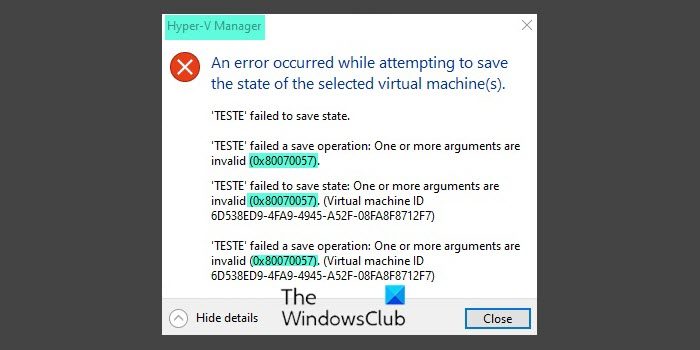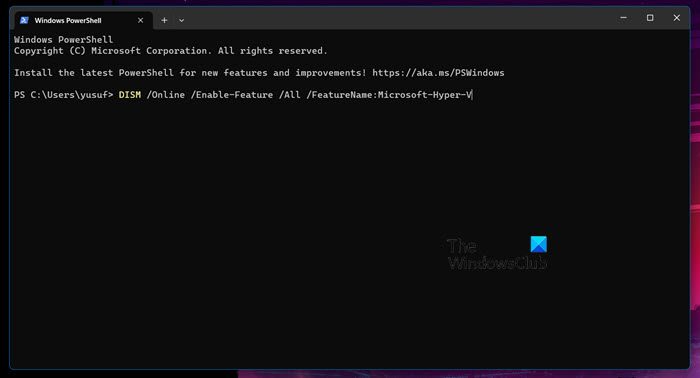We can run Windows 11/10, or other platforms like Linux simultaneously on a single machine on Hyper-V or any other Virtual Machine platform. However, some users have reported that when trying to enable Hyper-V or start a VM in the Hyper-V manager they get the error 0x80070057.In this article, we will see what you can do if you see Hyper-V Error Code 0x80070057.

The errors seen are:
Hyper-V failed to start worker process, One or more arguments are invalid, Error Code 0x80070057
OR
An error occurred while attempting to save the state of the selected virtual machine, One or more arguments are invalid, Error Code 0x80070057
OR
Windows couldn’t complete the requested changes.
The parameter is incorrect.
Error code: 0x80070057
What is 0x80070057 VM error?
Error Code 0x80070057 doesn’t allow users to enable Hyper-V or start a VM in the Hyper-V manager on their Windows computer. The error code is usually a result of an incorrect parameter or corrupted or missing system files.
Fix 0x80070057 Hyper-V Error on Windows computer
If you see Hyper-V Error Ccode 0x80070057 when you try to enable Hyper-V using Windows Features or start a VM in the Hyper-V Manager then use the solution given below to resolve this problem.
- Check that the computer meets the minimum system requirement
- Enable Hardware Virtualization
- Enable Hyper-V using PowerShell
- Configure Registry
Let’s get started.
1] Check system meets the minimum system requirement
First of all, we should see the system requirement of Hyper-V. You will not be able to enable Hyper-V if the system requirement is not met. So, make sure that your computer is able to match the system requirement mentioned below.
- Processor: 2 (or more) core compatible 64-bit processor equipped with 1 GHz (or faster)
- RAM: 4 GB or higher
- System storage: 64 GB Minimum or higher
- System firmware needs to support UEFI and Secure Boot
- Support for Trusted Platform Module (TPM) version 2.0
- The Graphics card needs to be compatible with DirectX 12 or later
Support for WDDM 2.0 driver - Display that supports 720p HQ with a size greater than 9″ diagonally with an 8 Bits/color panel
If you have covered these system requirements, move to the next solution.
Read: Hyper-V Virtual Machine stuck in Saved State
2] Enable Hardware Virtualization
If you are unable to turn on Hyper-V, then go ahead and enable Hardware Virtualization. Hyper-V Virtualization is required to create a VM, and sometimes, Hyper-V refuses to turn on if the feature is disabled in BIOS. By default, the feature is enabled, but a BIOS or system update can disable the same. So, go ahead and enable Hardware Virtualization on your computer and retry.
3] Enable Hyper-V using PowerShell

Most of us are not aware of the fact that we don’t always have to use the GUI to enable Hyper-V, instead, we can go for a PowerShell command to do the same. For some victims, one can easily enable Hyper-V using a PowerShell command. Follow the steps mentioned below to do the same.
- Press Windows key and type PowerShell and select Run as Administrator.
- Type the following command:
DISM /Online /Enable-Feature /All /FeatureName:Microsoft-Hyper-V
- Once the process is completed, restart the computer.
Now, check whether Hyper-V is enabled or not.
4] Configure Registry
If a VM is not starting in Hyper-V, it is very likely that some registry key is misconfigured or needs some alteration. The alteration is required because McAfee VirusScan Enterprise 8.8 Patch 5 creates mfedisk string that interferes with Hyper-V.
Before making any changes, create a backup of the registry as that can be used if something goes wrong. After creating a backup, open Registry Editor and go to the following location.
HKEY_LOCAL_MACHINE\SYSTEM\CurrentControlSet\Control\Class\{4d36e967-e325-11ce-bfc1-08002be10318}
Look for mfedisk and delete it.
Finally, reboot your computer and check if the issue is resolved.
Hopefully, you can resolve the issue using the solutions mentioned in this article.
Read: Error 0x80370102, Virtual machine could not be started
How do I fix error code 0x80070057?
See this post if you receive error 0x80070057 on Windows 11/10 when using Windows Update, Installing or Upgrading Windows, running Windows Backup, etc., then you will see this ubiquitous error code when one or more arguments are not valid.